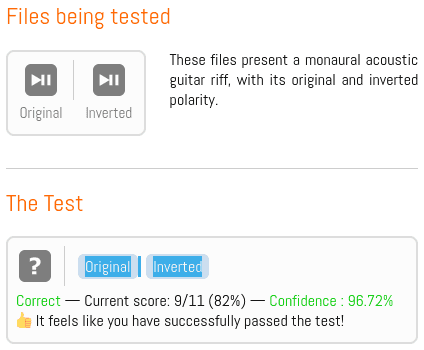Sure but what about your worst 210° example, wouldn’t it actually be better in my example?540 - 360 : 180
imo 160 is the better one
There’s three serious problems with that: Firstly, just flipping the polarity of one mic will not “line the phase up with each other” because the phase difference to start with is almost never 180°. Secondly, if you line up the phase due to different distances from mic to sound source, then you’ll destroy the psychoacoustic panning effect which absolutely relies on that phase difference and that would be completely catastrophic in the case of a binaural 2 mic setup. Thirdly, in the two examples I gave we’re not talking about a 2 mic setup, we’re talking about a roughly 9 to 40 or more mic setup and if you line up the phase between any two mics then you’ll make the phase differential worse with the various other mics.Well sorry, actually if you talk about 2 mic setups you may flip one mic's polarity, so the recorded phase lines up with eachother because of different distances from mic to sound source, and i guess you could in theory line them up "perfectly" instead of just flipping the polarity "to make them somewhat lineup"
If you were a music or sound engineer you would know the answer to that question! For everyone else: With music, the most common use of flipping the phase (inverting the polarity) of a mic/channel is with a drum kit, where it’s quite common (though not always the case) to use two mics on the snare drum, one next the top/batter head and one underneath next to the bottom/snare head. This always results in a phase differential to the point of some amount of audible phase cancellation but just as the phase differential in this scenario is never 0°, it’s also never 180°. So one of the first things an engineer will do when commencing mixing the drum kit is to flip the phase of one of the snare mics to compare the resultant freq response, which is virtually always different. Typically the difference can be heard most obviously in the amount of low-mid freqs. One of the states, flipped or unflipped, will provide “better” phase coherence (be closer to 0°) and there will be significantly more low-mid freqs. However, it is sometimes not desirable to have significantly more low-mid freqs in the snare sound as this can overlap/interfere with the same freqs produced by other instruments or the vocals. Therefore, it is sometimes the case that the “worse” phase state is chosen, the one which results in more phase cancellation.Why is artistic use of phase important here? let them do their thing
No, the absolute phase is not audible. It’s audible with test signals but almost never with actual music recordings because the phase is so messed up anyway. There maybe some very rare outliers to this general rule, under certain specific unusual circumstances, but even if someone ever actually comes across such a rarity, the audible difference is not more than very subtle anyway, there are much bigger fish to fry.the point is absolute phase is audible, no matter how messed up the actual phase is of a particular song
But you cannot make sure of that. It is extremely unlikely you will have the same speakers and you definitely will not have the same room acoustics. These and other factors are bigger fish to fry, have far more effect than the absolute phase polarity even in those outlier cases where it might be detectable. However, “like the artist intended” (and the engineers/producer) is actually a range, because no one expects that consumers will have the same or even particularly near the same speakers/acoustics as the recording or mastering studios where the musicians and engineers created the recording and indeed, that’s why we have the mastering process in the first place. The difference with absolute phase is either non-existent, inaudible or on those extremely rare examples where it is audible, so subtle that it falls within the “intended range” anyway. And this is why, contrary to your assertion, it is not “a controversial topic”, it’s an irrelevant topic and, an actual engineer would know that!just make sure you listen to it like the artist intended
G
Last edited:











 :
:






